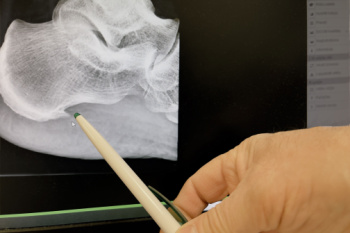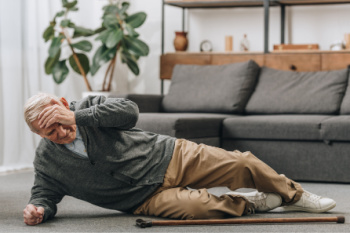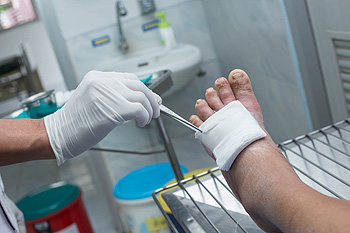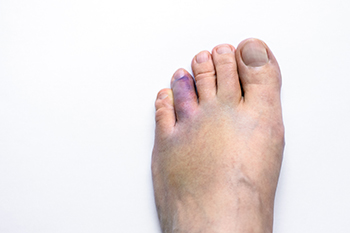January 2025
Are Bunions Affecting Your Everyday Life?
Definition and Risk Factors of Heel Spurs

A heel spur is a bony growth that forms on the underside of the heel bone, often as a result of prolonged strain and pressure on the foot. This condition is commonly associated with plantar fasciitis, an inflammation of the tissue along the bottom of the foot. The main symptom of a heel spur is sharp pain at the bottom of the heel, particularly when standing up after a period of rest, such as first thing in the morning. The pain can also worsen after prolonged periods of standing or walking. Risk factors for developing heel spurs include being overweight, having flat feet or high arches, and wearing improper footwear. Also, engaging in activities that put excessive strain on the feet, such as running or standing for long periods of time may lead to developing a heel spur. Age and certain medical conditions, like diabetes, can increase the likelihood of developing heel spurs as well. If you have heel pain, it is suggested that you consult a podiatrist who can provide an accurate diagnosis and treatment.
Heel spurs can be incredibly painful and sometimes may make you unable to participate in physical activities. To get medical care for your heel spurs, contact Naim G. Shaheed, DPM from Ankle and Foot Centers of Georgia. Our doctor will do everything possible to treat your condition.
Heels Spurs
Heel spurs are formed by calcium deposits on the back of the foot where the heel is. This can also be caused by small fragments of bone breaking off one section of the foot, attaching onto the back of the foot. Heel spurs can also be bone growth on the back of the foot and may grow in the direction of the arch of the foot.
Older individuals usually suffer from heel spurs and pain sometimes intensifies with age. One of the main condition's spurs are related to is plantar fasciitis.
Pain
The pain associated with spurs is often because of weight placed on the feet. When someone is walking, their entire weight is concentrated on the feet. Bone spurs then have the tendency to affect other bones and tissues around the foot. As the pain continues, the feet will become tender and sensitive over time.
Treatments
There are many ways to treat heel spurs. If one is suffering from heel spurs in conjunction with pain, there are several methods for healing. Medication, surgery, and herbal care are some options.
If you have any questions feel free to contact one of our offices located in Lithonia/Stonecrest and Emory/Midtown, GA . We offer the latest in diagnostic and treatment technology to meet your needs.
Understanding the Causes of Falls in the Elderly

Falls are a common concern among older adults and can lead to serious injuries. One major factor contributing to falls among seniors is the decline in physical fitness that naturally occurs with aging. As strength, flexibility, and coordination decrease, the risk of losing balance increases. Impaired vision, which becomes more prevalent with age, can make it difficult for seniors to detect obstacles or changes in their environment, raising the likelihood of tripping or stumbling. Medication side effects, such as dizziness or drowsiness, can also increase the risk of falls, especially when multiple medications are taken simultaneously. Chronic diseases like arthritis, diabetes, and Parkinson’s disease can affect mobility, making it harder to move safely. Additionally, surgical procedures or recovery from surgery can lead to temporary weakness, affecting balance and stability. If you have sustained a foot or ankle injury from falling, it is suggested that you promptly consult a podiatrist who can offer effective treatment solutions, and educate you on additional fall prevention techniques.
Preventing falls among the elderly is very important. If you are older and have fallen or fear that you are prone to falling, consult with Naim G. Shaheed, DPM from Ankle and Foot Centers of Georgia. Our doctor will assess your condition and provide you with quality advice and care.
Every 11 seconds, an elderly American is being treated in an emergency room for a fall related injury. Falls are the leading cause of head and hip injuries for those 65 and older. Due to decreases in strength, balance, senses, and lack of awareness, elderly persons are very susceptible to falling. Thankfully, there are a number of things older persons can do to prevent falls.
How to Prevent Falls
Some effective methods that older persons can do to prevent falls include:
- Enrolling in strength and balance exercise program to increase balance and strength
- Periodically having your sight and hearing checked
- Discuss any medications you have with a doctor to see if it increases the risk of falling
- Clearing the house of falling hazards and installing devices like grab bars and railings
- Utilizing a walker or cane
- Wearing shoes that provide good support and cushioning
- Talking to family members about falling and increasing awareness
Falling can be a traumatic and embarrassing experience for elderly persons; this can make them less willing to leave the house, and less willing to talk to someone about their fears of falling. Doing such things, however, will increase the likelihood of tripping or losing one’s balance. Knowing the causes of falling and how to prevent them is the best way to mitigate the risk of serious injury.
If you have any questions, please feel free to contact one of our offices located in Lithonia/Stonecrest and Emory/Midtown, GA . We offer the newest diagnostic and treatment technologies for all your foot care needs.
Treating Diabetic Foot Ulcers

Diabetic foot ulcers can be a significant complication for people with diabetes due to reduced sensation and poor circulation in the feet. These ulcers often develop from minor injuries or pressure points that go unnoticed, as decreased nerve function can mask pain, and poor circulation inhibits healing. A podiatrist plays an essential role in diagnosing and managing foot ulcers to prevent serious infections. Treatment typically includes debridement, which involves removing dead or infected tissue to clean the wound and stimulate recovery. A podiatrist will also assess the depth and severity of the ulcer, ensuring that no foreign materials are present. Protective measures, such as specialized footwear or casts, may be recommended to reduce pressure on the affected area. Regular wound care, including cleaning and dressing changes, further supports recovery. Maintaining controlled blood sugar levels is vital, as it aids in faster healing and reduces the risk of infection. If you have foot ulcers as a result of diabetes, it is suggested that you schedule regular appointments with a podiatrist.
Diabetic foot care is important in preventing foot ailments such as ulcers. If you are suffering from diabetes or have any other concerns about your feet, contact Naim G. Shaheed, DPM from Ankle and Foot Centers of Georgia. Our doctor can provide the care you need to keep you pain-free and on your feet.
Diabetic Foot Care
Diabetes affects millions of people every year. The condition can damage blood vessels in many parts of the body, especially the feet. Because of this, taking care of your feet is essential if you have diabetes, and having a podiatrist help monitor your foot health is highly recommended.
The Importance of Caring for Your Feet
- Routinely inspect your feet for bruises or sores.
- Wear socks that fit your feet comfortably.
- Wear comfortable shoes that provide adequate support.
Patients with diabetes should have their doctor monitor their blood levels, as blood sugar levels play such a huge role in diabetic care. Monitoring these levels on a regular basis is highly advised.
It is always best to inform your healthcare professional of any concerns you may have regarding your feet, especially for diabetic patients. Early treatment and routine foot examinations are keys to maintaining proper health, especially because severe complications can arise if proper treatment is not applied.
If you have any questions please feel free to contact one of our offices located in Lithonia/Stonecrest and Emory/Midtown, GA . We offer the newest diagnostic and treatment technologies for all your foot and ankle needs.
How to Handle a Broken Toe That Does Not Heal

A broken toe that does not heal can be a frustrating and painful experience. If you have noticed persistent pain, swelling, or difficulty moving the toe despite following basic treatment guidelines, it may be time to consult a podiatrist. A non-healing fracture could indicate a more serious issue, such as improper alignment, insufficient rest, or an underlying health condition like osteoporosis. A podiatrist may recommend additional treatments such as immobilization with a special shoe or splint, or surgery to realign the bones properly. Specific stretches may also be suggested to restore strength and flexibility. If you have a broken toe or continue to be uncomfortable, it is suggested that you consult a podiatrist who can provide appropriate treatment solutions.
Broken toes may cause a lot of pain and should be treated as soon as possible. If you have any concerns about your feet, contact Naim G. Shaheed, DPM from Ankle and Foot Centers of Georgia. Our doctor will treat your foot and ankle needs.
What Is a Broken Toe?
A broken toe occurs when one or more of the toe bones of the foot are broken after an injury. Injuries such as stubbing your toe or dropping a heavy object on it may cause a toe fracture.
Symptoms of a Broken Toe
- Swelling
- Pain (with/without wearing shoes)
- Stiffness
- Nail Injury
Although the injured toe should be monitored daily, it is especially important to have a podiatrist look at your toe if you have severe symptoms. Some of these symptoms include worsening or new pain that is not relieved with medication, sores, redness, or open wounds near the toe.
If you have any questions, please feel free to contact one of our offices located in Lithonia/Stonecrest and Emory/Midtown, GA . We offer the newest diagnostic and treatment technologies for all your foot care needs.









